
A fishing trawler is a commercial fishing vessel designed to operate fishing trawls. Trawling is a method of fishing that involves actively dragging or pulling a trawl through the water behind one or more trawlers. Trawls are fishing nets that are pulled along the bottom of the sea or in midwater at a specified depth. A trawler may also operate two or more trawl nets simultaneously.

The United States Fish Commission, formally known as the United States Commission of Fish and Fisheries, was an agency of the United States government created in 1871 to investigate, promote, and preserve the fisheries of the United States. In 1903, it was reorganized as the United States Bureau of Fisheries, sometimes referred to as the United States Fisheries Service, which operated until 1940. In 1940, the Bureau of Fisheries was abolished when its personnel and facilities became part of the newly created Fish and Wildlife Service, under the United States Department of the Interior.
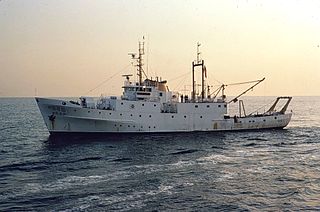
NOAA Ship Albatross IV, originally BCF Albatross IV, was a fisheries research ship in commission in the United States Fish and Wildlife Service's Bureau of Commercial Fisheries from 1963 to 1970 and in the National Oceanic and Atmospheric Administration (NOAA) from 1970 to 2008.

NOAAS Delaware II was a National Oceanic and Atmospheric Administration (NOAA) fisheries research vessel in commission from 1970 to 2012. Prior to her NOAA career, she was in commission in the fleet of the United States Fish and Wildlife Service's Bureau of Commercial Fisheries from 1968 to 1970 as US FWS Delaware II. After her NOAA career ended, she was sold and in 2014 was converted into the research and survey ship RV Med Surveyor, operating under the flag of Panama.
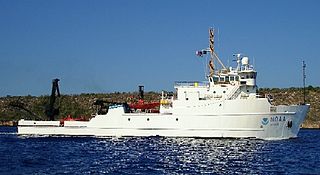
The NOAA Ship Nancy Foster is a National Oceanic and Atmospheric Administration research vessel. The ship is named for Dr. Nancy Foster, who was the director of the National Marine Fisheries Service’s Office of Protected Resources from 1986 until 1993, and the director of the National Ocean Service from 1997 until her death in 2000.

The first USS Patuxent was a fleet tug in commission in the United States Navy from 1909 to 1924. She served the United States Atlantic Fleet and saw service in World War I. After the end of her Navy career, she was in commission in the United States Bureau of Fisheries from 1926 to 1932 as the fisheries research ship USFS Albatross II.
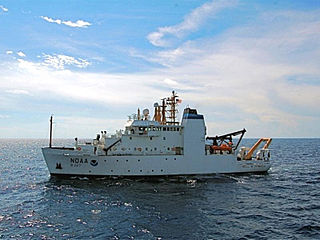
NOAAS Bell M. Shimada is an American fisheries research ship in commission with the National Oceanic and Atmospheric Administration (NOAA) since 2010. She operates along the United States West Coast.

NOAAS Reuben Lasker is a National Oceanic and Atmospheric Administration (NOAA) fishery research vessel. The ship's namesake, Reuben Lasker, was a fisheries biologist who served with the Southwest Fisheries Center, National Marine Fisheries Service, and taught at the Scripps Institution of Oceanography. This class of NOAA ships is very similar to, and based in part upon, the Neil Armstrong-class Oceanographic Research (AGOR) ships owned by the Office of Naval Research and operated by various US Universities.

USFC Fish Hawk was a fisheries science research ship operated by the United States Commission of Fish and Fisheries, commonly called the United States Fish Commission, from 1880 to 1903 and as USFS Fish Hawk by its successor, the United States Bureau of Fisheries, from 1903 1918 and from 1919 to 1926. She was the first large ship purpose-built by any country for the promotion of fisheries, and spent her 46-year career operating along the United States East Coast, in the Gulf of Mexico, and off Puerto Rico.

NOAAS Oregon II is an American fisheries research vessel in commission in the National Oceanic and Atmospheric Administration (NOAA) fleet since 1977. Prior to her NOAA career, she was delivered to the United States Fish and Wildlife Service's Bureau of Commercial Fisheries in 1967 and was transferred to NOAA in 1970, but was not placed in commission until 1977.
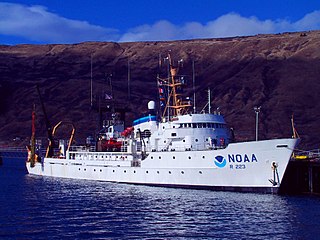
NOAAS Miller Freeman was an American fisheries and oceanographic research vessel that was in commission in the National Oceanic and Atmospheric Administration (NOAA) fleet from 1975 to 2013. Prior to her NOAA career, she was in commission in the United States Fish and Wildlife Service's Bureau of Commercial Fisheries from 1967 to 1970 as US FWS Miller Freeman.

NOAAS Chapman was an American fisheries research vessel that was in commission in the National Oceanic and Atmospheric Administration (NOAA) fleet from 1980 to 1998. After the conclusion of her NOAA career, she spent several years operating as the University of Puerto Rico marine research vessel R/V Chapman. More recently, she has become the Curaçao-based mothership for the deep-diving submarine Curasub.

NOAAS David Starr Jordan (R444)) was an American fisheries research vessel in commission in the National Oceanic and Atmospheric Administration (NOAA) from 1970 to 2010. She previously was in the United States Fish and Wildlife Service's Bureau of Commercial Fisheries fleet from 1966 to 1970 as US FWS David Starr Jordan.
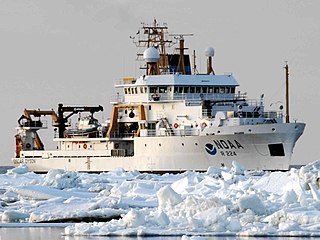
NOAAS Oscar Dyson is an American fisheries and oceanographic research vessel in commission in the National Oceanic and Atmospheric Administration (NOAA) fleet since 2005.

NOAAS Pisces is an American fisheries and oceanographic research vessel in commission in the National Oceanic and Atmospheric Administration (NOAA) fleet since 2009.

RV Huxley was the first research vessel used by the Marine Biological Association of the United Kingdom explicitly for fisheries research and is regarded as the first vessel yielding data for the Ministry of Agriculture, Fisheries and Food - Directorate of Fisheries, now known as the Centre for Environment, Fisheries and Aquaculture Science (Cefas).

MV Brown Bear was an American research vessel in commission in the fleet of the United States Department of Agriculture′s Bureau of Biological Survey and Alaska Game Commission from 1934 to 1940 and in the fleet of the United States Department of the Interior′s Fish and Wildlife Service from 1940 to 1942 and from 1946 to 1951, under the control of the University of Washington from 1952 to 1965, and in commission in the fleet of the United States Fish and Wildlife Service from 1965 to 1970 and of the National Oceanic and Atmospheric Administration′s National Marine Fisheries Service (NMFS) from 1970 to 1972.

USFS Pelican was an American fisheries science research ship and fishery patrol vessel that operated along the United States East Coast and the United States Gulf Coast and in the waters of the Territory of Alaska. She was part of the United States Bureau of Fisheries (BOF) fleet from 1930 to 1940. She then served as US FWS Pelican in the fleet of the Fish and Wildlife Service – from 1956 the United States Fish and Wildlife Service – from 1940 to 1958. She served as a fishery patrol vessel while on loan to the Washington Department of Fish and Wildlife from 1958 to 1970, then briefly returned to the Fish and Wildlife Service's successor agency, the National Marine Fisheries Service. Her United States Government service ended when she was sold into private hands in 1972, and she remained extant as of 2010. In 2017 Captain Patrick Burns and Captain John (Johnny) Sylvester purchased the Pelican from Marilyn Masland. She is currently moored in Deer Harbor on Orcas Island, WA. In 2018 she was brought up the Inside Passage to Alaska and back to Washington.





















